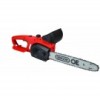Harbor Freight Tools 67255 User Manual - Page 12
Workpiece and Work Area Set Up, Instructions concerning the proper techniques for, basic felling,
 |
View all Harbor Freight Tools 67255 manuals
Add to My Manuals
Save this manual to your list of manuals |
Page 12 highlights
Safety Setup Operating Instructions Read the ENTIRE IMPORTANT SAFETY INFORMATION section at the beginning of this manual including all text under subheadings therein before set up or use of this product. Workpiece and Work Area Set Up 1. Designate a work area that is clean and well lit. The work area must not allow access by children or pets to prevent distraction and injury. 2. Route the extension cord along a safe route to reach the work area without creating a tripping hazard or exposing the extension cord to possible damage. The extension cord must reach the work area with enough extra length to allow free movement while working. Position the cord so that it will not be caught on branches and the like during cutting. 3. Secure the extension cord by snapping it in the Power Cord Clip so there will be no tension on the connection between the Power Cord and the extension cord. 4. There must not be objects, such as utility lines, nearby that will present a hazard while working. 5. Attach to outlet using a Residual Current Device or Ground Fault Circuit Interrupter (GFCI) with a tripping current of 30 mA or less. 6. A first-time user should, as a minimum practice, cut logs on a saw-horse or cradle before cutting down trees. Instructions concerning the proper techniques for basic felling, limbing, and cross-cutting Felling a Tree When bucking and felling operations are being performed by two or more persons at the same time, the felling operations should be separated from the bucking operation by a distance of at least twice the height of the tree being felled. Trees should not be felled in a manner that would endanger any person, strike any utility line or cause any property damage. If the tree does make contact with any utility line, the company should be notified immediately. The chain saw operator should keep on the uphill side of the terrain as the tree is likely to roll or slide downhill after it is felled. An escape path should be planned and cleared as necessary before cuts are started. The escape path should extend back and diagonally to the rear of the expected line of fall as illustrated in Figure E. Before felling is started, consider the natural lean of the tree, the location of larger branches and the wind direction to judge which way the tree will fall. Remove dirt, stones, loose bark, nails, staples and wire from the tree. Felling Direction Danger Zone Escape Route Danger Zone Escape Route Figure E: Escape Routes Operation Maintenance Page 12 For technical questions, please call 1-888-866-5797. Item 67255















